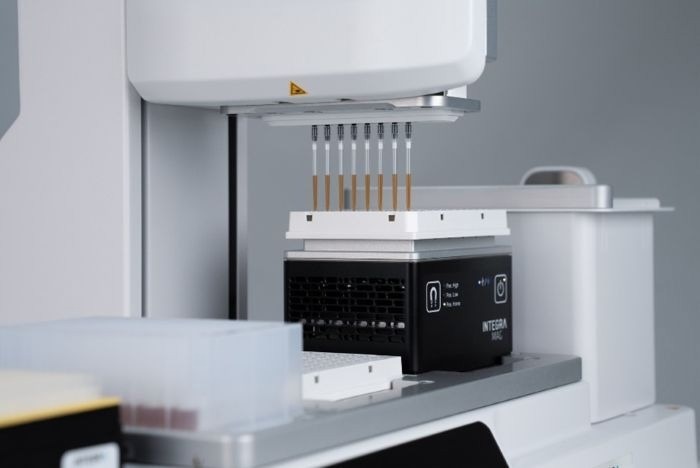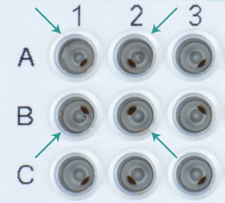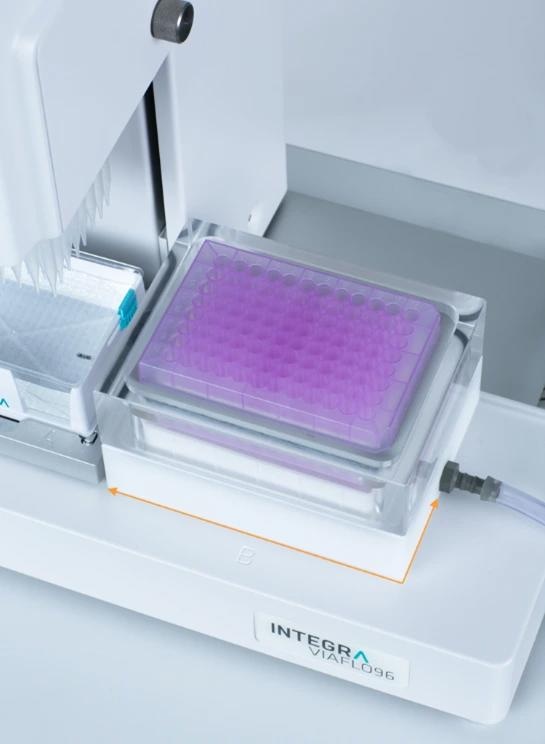PCR is a strong laboratory technique that amplifies nucleic acid materials for molecular biology applications like sequencing and gene expression profiling.
PCR purification, also known as PCR clean-up, is the process of removing undesirable compounds and leftover reaction components, such as unincorporated deoxyribonucleotides (dNTPs), primers, primer dimers, salts, and enzymes used in the amplification process.
This critical process ensures the cleanliness of DNA samples generated for use in subsequent applications. This article covers the most prevalent PCR purification methods and how INTEGRA Biosciences’ solutions can assist in improving your operations.
PCR purification is essential for removing undesirable molecules that may interfere with downstream applications, ensuring that only the amplicons of interest remain.
Magnetic beads or spin column PCR purification are standard approaches for doing this. INTEGRA provides solutions to support both procedures, but PCR purification with magnetic beads is recommended because these protocols are easily automated, boosting valuable walk-away time while reducing errors and improving the reproducibility of your results.
How does magnetic bead purification work?
PCR purification with magnetic beads consists of three steps: binding, washing, and elution.
The liquid handling procedures can be automated on benchtop platforms, removing the time-consuming centrifugation and vacuum manifold steps required by spin column techniques. This enhances process reproducibility, boosts throughput, and saves time.

Image Credit: INTEGRA Biosciences
Step 1: Binding
To eliminate DNA fragments <100 bp, magnetic beads are added to the sample at a precise ratio, typically 1.8x. This is followed by mixing and incubation to help the DNA amplicons adhere to the beads.
The bead-bound amplicons are then collected via magnetic separation. This allows the supernatant containing smaller DNA fragments, such as primers and primer dimers, to be easily aspirated and discarded, separating the nucleic acids.
Step 2: Washing
Other undesirable components, such as unincorporated dNTPs, enzymes, and salts, are removed by adding ethanol to the sample, mixing it, and then repeating the magnetic separation.
The ethanol containing the undesired components is aspirated and discarded, and an air-drying process ensures that the residual solvent is completely evaporated to avoid interference with subsequent applications.
Step 3: Elution
Finally, a low-salt elution buffer or nuclease-free water resuspends the dried beads and releases the attached DNA, or amplicons, back into solution. The beads are subsequently isolated from the eluate using magnetic separation, which allows for the collection of high-quality, purified DNA for downstream applications.
How to improve your magnetic bead PCR purification methods
INTEGRA provides various solutions to make life in the lab easier and magnetic bead PCR purification operations more efficient.
- MAGFLO™ magnetic beads for PCR purification*: MAGFLO PCR magnetic beads provide high amplicon recovery rates. You can get a free 1 ml sample to try for yourself.
- MAG module: INTEGRA’s magnetic module is an effective alternative to typical magnetic stands. Automated vertical magnet motions eliminate the need to transfer tubes and plates to and from magnetic platforms, reducing the risk of spillage. In addition, beads are collected in a single location rather than creating a ring-shaped pellet, making it easier to aspirate supernatants without disruption. Several adapters are provided for different labware types, allowing for a perfect fit between the sample containers and magnets, ensuring that all beads are caught and good yields are achieved. To increase efficiency even further, the MAG module can be paired with INTEGRA’s benchtop platforms, the VIAFLO 96 and VIAFLO 384 portable electronic pipettes, and the ASSIST PLUS pipetting robot, to create semi- or fully automated workflows.

Image Credit: INTEGRA Biosciences
- The ASSIST PLUS pipetting robot: This robot automates the electronic multichannel pipettes and integrates with the MAG module for fully automated, walk-away PCR purification procedures. Unlike larger liquid handling robots, this cost-effective solution may be set up without any prior programming experience. INTEGRA also offers template scripts for your convenience.
- INTEGRA’s VIAFLO 96 and VIAFLO 384 handheld electronic pipettes: These allow for semi-automated liquid transfers of up to 96 or 384 samples at once. Combined with a MAG module, they are excellent for high-throughput, complete plate magnetic bead purification operations.
How does spin column purification work?
PCR purification with spin columns comprises binding, washing, and elution processes, such as magnetic bead-based procedures. Spin columns with a membrane with high affinity for nucleic acids are put into microcentrifuge tubes.
Samples are transferred to the spin column and centrifuged to separate DNA amplicons of a certain size. These bind to the membrane, allowing most undesirable components, such as primers and primer dimers, to pass through.
Add a wash buffer to the spin column and centrifuge to eliminate undesirable residual components. Finally, add the elution buffer, and the column is centrifuged again to separate the pure DNA amplicons of interest from the membrane.
Spin columns are offered as separate columns or 96-well silica membrane plates that can be placed on a vacuum manifold rather than centrifuged, allowing you to optimize the process for increased throughput.
Certain disadvantages of using a spin column instead of magnetic beads for purification exist. The membranes can readily become clogged, and the minimum elution volume is bigger, resulting in lower DNA concentrations.
The procedure also comprises many hands-on steps using a centrifuge or vacuum manifold that are difficult to automate, raising the possibility of human error.
How to streamline your spin column PCR purification protocols
Several of INTEGRA’s liquid handling technologies can help you streamline your spin column workflows, including:
- VOYAGER pipettes with adjustable tip spacing allow for easy buffer transfer from reservoirs to spin columns or silica membrane plates, removing the requirement for single-channel pipettes.
- The VIAFLO 96 and 384 channel pipettes allow for parallel pipetting of buffers into all 96 wells of a silica membrane plate, minimizing hands-on time.

Image Credit: INTEGRA Biosciences
*MAGFLO PCR beads are now only accessible in Austria, Denmark, Germany, Sweden, Switzerland, and the United Kingdom.
About INTEGRA Biosciences
INTEGRA provides innovative solutions for liquid handling and media preparation applications that serve the needs of their customers in research, diagnostics, and quality control laboratories.
Their instruments and plastic consumables are developed and manufactured in Zizers, Switzerland, and Hudson, NH, USA. In order to remain close to their customers, they maintain a direct sales and support organization in several North American, European, and Asian countries, as well as a network of over 100 highly trained distribution partners worldwide.
In recent years they have focused on developing a new and technologically advanced range of lab devices that are simple to use and meet the ergonomic needs of their customers.
Today they are proud to offer the widest range of electronic pipettes in the market spanning a range from single channel pipettes up to 384 channel bench-top instruments.
Sponsored Content Policy: News-Medical.net publishes articles and related content that may be derived from sources where we have existing commercial relationships, provided such content adds value to the core editorial ethos of News-Medical.Net which is to educate and inform site visitors interested in medical research, science, medical devices and treatments.